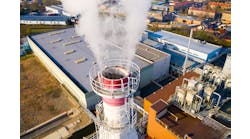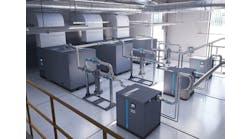Chemical makers want to increase the sustainability of their operations but always must keep costs in mind. Fortunately, enhancing the sustainability of a plant and significantly improving the triple bottom line (people, planet, profit) of a company doesn’t have to blow the budget. Some relatively inexpensive measures can keep a plant running at peak efficiency, providing year after year cost reductions and holding its carbon footprint in check. Here, we’ll look at several steps: loop tuning, boiler tuning, addressing steam leaks, using variable frequency drives (VFDs) and lighting upgrades. These steps can yield decent savings on their own, but combined as a program, could provide a substantial boost.
Loop Tuning
A well-tuned loop enables a controller to get a desired output based on a set point in a repeatable and accurate manner. Having valves oscillate greatly to find that desired output costs a plant power, time and money. Good efficient control of a loop yields energy savings, minimizes raw material losses and contributes to more-consistent product quality. In contrast, a loop that’s not tuned properly not only undermines performance but also may pose a safety issue.
Valves constantly wear — the more a valve travels, the more wear it likely will suffer. To put this into perspective, a valve may travel five to ten times more than necessary to have the same output in a tuned loop. The greater a loop is out of tune, the greater the valve travels. This extra movement does two things. It prematurely wears out the valve, causing more frequent removal from service and rebuilding, which can be quite costly. Operating the valve also requires more power, which puts an unnecessary added burden on your pneumatic system. Multiply that extra power by the number of valves in the system and the impact can be enormous.
[javascriptSnippet ]
Many different methods can tune loops. Quite a few very good software packages optimize loop tuning; these are relatively low cost compared to doing manual Ziegler-Nichols tuning on each loop, which can be very time consuming. However, some people contend the automated tuning packages are meant for newer valves and don’t take into account the wear in the linkages. Regardless of whether you use an automated or manual approach, the payback period for tuning a loop sometimes is only a matter of hours. Loop tuning may be the most important element of improving energy efficiency.
While performing these loop tunings, also look for leaking instrument air. Stopping such leaks can provide additional savings. Compressed air is a considerable expense at most plants, typically around $100/scfm. So, a careful investigation of the overall compressed-air system often can lead to significant savings. (For more on optimizing compressed-air systems, see: “Properly Assess Compressed Air Demand” and “Energy Savings are Often Disguised as Problems.”)
Boiler Tuning
An inefficient, poorly maintained boiler wastes money and makes a plant’s carbon footprint larger than necessary. Keeping a boiler tuned reduces greenhouse gases and saves money in the long run. Cutting the fuel consumption of a boiler directly results in less air pollution. Tuning up a boiler allows precise measurement of the required air/fuel ratio. A good maintenance program is imperative for an efficient boiler.
There are four main objectives in making a boiler more efficient: reducing the stack losses, cutting the amount of excess air used, improving heat transfer and recovering waste heat. Here’s a high-spotting of what to do:
• Stack losses. Measure and monitor flue-gas temperature. The system can absorb more heat by decreasing that temperature. Reducing air leaks and keeping your stacks and airways free of soot are essential for achieving optimal stack performance.
• Excess air. Test and monitor oxygen levels and reduce or eliminate air leaks in the boiler. To precisely control the airflow, either install or adjust air dampers and put in or calibrate oxygen controls.
• Heat transfer. Keep boiler tubes clean, free of scale and fouling.
• Heat recovery. Collect the steam condensate from traps and add it to the feed water to improve heat recovery. In addition, employing stack economizers to pre-heat boiler feed water can pay extra dividends.
Unlike tuning a simple control loop, you must meet a variety of objectives to bring a boiler to optimal efficiency. This is especially the case for boilers that are multi-fuel, e.g., that burn oil and coal or other solids. These boilers are subject to strict emissions limits and may require further testing under new U.S. Environmental Protection Agency guidelines. To maintain these limits, the boiler may need tuning more often than the specified 24-mo cycle.
Good communication between plant operations and the boiler operator is key to obtaining further efficiencies. Alerting the boiler operator to process changes or upsets will help that person better deal with load changes. However, communications can be very difficult, especially in a continuously changing production environment.
While not exactly low-hanging fruit or low cost, consider replacing your boiler package if it’s old; it may be a false economy to continue to operate it. A new boiler does involve a considerable investment but its payback period may be much shorter than you might think.
Steam Leaks
Every plant has steam leaks. Valve stems, steam traps, regulators, pipe joints and flanges leak. Even in low-pressure systems with just 150-lb steam, a single leak about the size of a pin head can cost almost $200/y. Leaking steam not only is costly but also can pose a safety hazard, which never should be taken lightly.
Performing an annual steam-leak survey is an effective way to combat these costs. Consider conducting this important survey in the fall when it’s cooler and the steam plumes are easier to spot. Another method is to use an ultrasonic detector, which can find the smallest leak even if obscured by piping insulation. An ultrasonic detector costs around $1,200 but pays for itself if it uncovers just one leaking steam trap. (For more on checking steam traps, see: “Listen to Your Steam Traps.”)
Steam traps are especially prone to leakage. The U.S. Department of Energy estimates at least 15–20% of all steam traps now installed are leaking or completely failed. A variety of hardware issues — including improper system design, and clogged or plugged condensate lines — can cause steam traps to start leaking. In addition, human factors may play a role, e.g., a trap’s bypass valve inadvertently may have been left open.
A steam leak from a trap typically is about 1/8-in. in diameter. This may seem pretty small but such a leak costs in the neighborhood of $15,000/y, depending upon fuel costs; a 3/16-in leak wastes upwards of $28,000/y. If 10% of steam traps leak, a plant literally can bleed money.
Motor Control Upgrade
VFDs provide a powerful tool for reducing operating costs, particularly in pumping applications. Every centrifugal pump has a flow rate at which it operates most efficiently. Unfortunately in many cases, the pump rarely operates at its best efficiency point. Traditionally, a fixed-speed motor drives the pump and a control valve throttles the output as needed. Excess fluid is recirculated, wasting a tremendous amount of energy. This is where VFDs shine. They adjust the motor speed to provide the exact flow rate wanted. With a VFD, for 80% of maximum flow rate, the pump consumes only 51% of the power it would use for full-speed operation, yielding a 49% savings. The benefits get even greater the slower the pump operates. For example, pumping at 60% of the maximum volume requires only 22% of the input power.
Replacing a pneumatic modulating valve used for flow control metering with a VFD may decrease the instrument air requirement significantly. On average, depending on the number of strokes and the actuator size, a valve conservatively costs at least $100/d to operate in instrument air, so each modulated valve eliminated saves $36,500/y. In addition, switching to a VFD obviates the costs of valve maintenance.
More-Efficient Lighting
Unless a plant was built in the past five years, it likely doesn’t have the latest in lighting technology, namely light emitting diodes (LEDs). LED lighting is one of the easiest and quickest methods to reduce power consumption and achieve annual savings. LED lighting is available in Class I, Div. II for those plants with that requirement. LED packages come in a variety of lighting patterns such as spot or flood. There’s even a fluorescent bulb substitute that only replaces the bulb and the ballast, not the entire fixture.
In addition to their low energy usage, these LED bulbs last significantly longer and radiate less heat than their fluorescent and incandescent counterparts. This simple lighting upgrade allows maintenance personnel extra time to investigate more-important problems such as plant air and steam leaks. The payback for LED lighting typically is less than four years. Moreover, a number of states offer rebate programs that make the return on investment even faster. By not taking advantage of these programs, plants simply are leaving money on the table.
Final Thoughts
The quest for sustainability is dynamic. It demands a formal program to identify opportunities and realize yearly savings. Such a program should include the areas mentioned here. Keep in mind that as improvements are made in one area, possible enhancements in other areas will present themselves. In addition, although not a requirement, a best practice is to solicit recommendations from a reputable systems integrator about the optimal solution for plant upgrades — especially when it comes to boilers, steam return systems and motor control.
You needn’t tackle all the upgrades at the same time. To get the desired cost reductions, focus on areas that clearly need improvement and implement changes incrementally. Once the returns on investment have been realized on a smaller scale, justifying a larger project will be easier.
MARK ADAIR is a Peachtree City, Ga.-based automation solution integrator for Avid Solutions, a certified member of the Control System Integrators Association (CSIA). E-mail him at [email protected].

